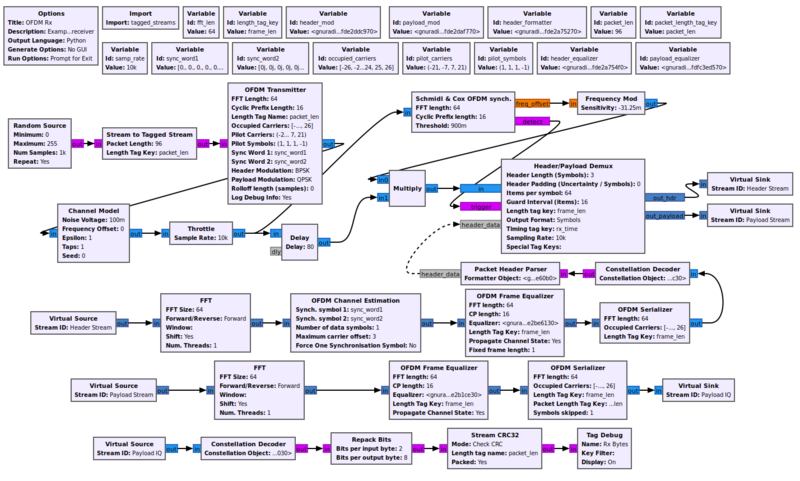OFDM Serializer: Difference between revisions
No edit summary |
(Restore missing elements from the header doc) |
||
| (One intermediate revision by one other user not shown) | |||
| Line 4: | Line 4: | ||
This is the inverse block to the [[OFDM Carrier Allocator]]. It outputs the complex data symbols as a tagged stream, discarding the pilot symbols. | This is the inverse block to the [[OFDM Carrier Allocator]]. It outputs the complex data symbols as a tagged stream, discarding the pilot symbols. | ||
If given, two different tags are parsed: The first key () specifies the number of OFDM symbols in the frame at the input. The second key () specifies the number of complex symbols that are coded into this frame. If given, this second key is then used at the output, otherwise, | If given, two different tags are parsed: The first key (Length Tag Key) specifies the number of OFDM symbols in the frame at the input. The second key (Packet Length Tag Key) specifies the number of complex symbols that are coded into this frame. If given, this second key is then used at the output, otherwise, Length Tag Key is used. If both are given, the packet length specifies the maximum number of output items, and the frame length specifies the exact number of consumed input items. | ||
It is possible to correct a carrier offset in this function by passing another tag with said offset. | It is possible to correct a carrier offset in this function by passing another tag with said offset. | ||
| Line 29: | Line 29: | ||
; Carrier Offset Key | ; Carrier Offset Key | ||
: When this block should correct a carrier offset, specify the tag key of the offset here (not necessary if following an | : When this block should correct a carrier offset, specify the tag key of the offset here (not necessary if following an [[OFDM Frame Equalizer]]) | ||
; Input is shifted | ; Input is shifted | ||
| Line 36: | Line 36: | ||
== Example Flowgraph == | == Example Flowgraph == | ||
This flowgraph can be found at [https://github.com/gnuradio/gnuradio/blob/master/gr-digital/examples/ofdm/rx_ofdm.grc]. | |||
[[File:Rx_ofdm_fg.png|800px]] | |||
== Source Files == | == Source Files == | ||
Latest revision as of 15:10, 3 August 2023
Serializes complex modulations symbols from OFDM sub-carriers.
This is the inverse block to the OFDM Carrier Allocator. It outputs the complex data symbols as a tagged stream, discarding the pilot symbols.
If given, two different tags are parsed: The first key (Length Tag Key) specifies the number of OFDM symbols in the frame at the input. The second key (Packet Length Tag Key) specifies the number of complex symbols that are coded into this frame. If given, this second key is then used at the output, otherwise, Length Tag Key is used. If both are given, the packet length specifies the maximum number of output items, and the frame length specifies the exact number of consumed input items.
It is possible to correct a carrier offset in this function by passing another tag with said offset.
- Input
- Complex vectors of length
- Output
- Complex scalars, in the same order as specified in occupied_carriers.
Parameters
- FFT length
- FFT length
- Occupied Carriers
- See OFDM Carrier Allocator
- Length Tag Key
- The key of the tag identifying the length of the input frame in OFDM symbols.
- Packet Length Tag Key
- The key of the tag identifying the number of complex symbols in this packet.
- Symbols skipped
- If the first symbol is not allocated as in occupied_carriers[0], set this
- Carrier Offset Key
- When this block should correct a carrier offset, specify the tag key of the offset here (not necessary if following an OFDM Frame Equalizer)
- Input is shifted
- If the input has the DC carrier on index 0 (i.e. it is not FFT shifted), set this to false
Example Flowgraph
This flowgraph can be found at [1].
Source Files
- C++ files
- [2]
- Header files
- [3]
- Public header files
- [4]
- Block definition
- [5]
